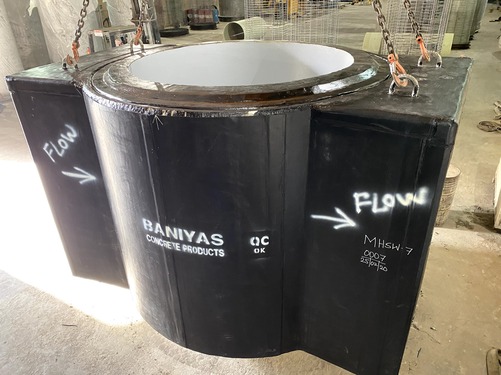Storm Water Manhole
Concrete manholes, GVCs (Gate Valve Chambers), ARVs (Air Release Valves), and washout chambers are key components of stormwater services infrastructure. Each plays a distinct role in managing stormwater flow, facilitating maintenance, and ensuring the effective operation of stormwater systems.
Concrete Manholes:
Structure and Design: Concrete manholes are vertical, cylindrical structures with a cover at the top. They are typically constructed with reinforced concrete and provide access to underground stormwater pipes for inspection, maintenance, and cleaning.
Uses:
Access Point: Manholes serve as access points for entering stormwater pipelines. They allow personnel to inspect the condition of pipes, remove debris, and perform maintenance activities.
Changes in Pipe Direction: Manholes are often used at points where stormwater pipes change direction or slope. They facilitate smooth transitions and allow for adjustments in the pipeline alignment.
Benefits:
Maintenance Accessibility: Concrete manholes provide easy access for maintenance crews, allowing for efficient inspection, cleaning, and repairs of stormwater pipelines.
Durability: Constructed with durable materials, concrete manholes withstand the corrosive effects of stormwater and offer long-term structural integrity.
GVC (Gate Valve Chamber):
Structure and Design: GVCs for stormwater services are similar to those used in potable water systems. They house gate valves, which control the flow of stormwater and allow for isolation during maintenance or emergencies.
Uses:
Flow Control: GVCs play a crucial role in controlling stormwater flow within the stormwater drainage network. Gate valves in these chambers regulate the movement of water and provide control points.
Emergency Isolation: In case of emergencies or repairs, gate valves in GVCs can be closed to isolate specific sections of the stormwater system, minimizing disruptions and potential damage.
Benefits:
Operational Control: GVCs enhance operational control by allowing for the isolation of sections of the stormwater system. This is valuable for routine maintenance and emergency response.
Reduced Flooding Risk: The ability to control stormwater flow helps mitigate the risk of flooding by regulating water levels during heavy rainfall events.
ARV (Air Release Valve) Chambers:
Structure and Design: ARV chambers house air release valves, which automatically release trapped air from the stormwater system. The chambers are designed to allow efficient venting of air pockets.
Uses:
Air Removal: ARV chambers prevent air accumulation in stormwater pipelines, which can impede the flow of water. The valves release trapped air, maintaining continuous flow and preventing performance issues.
Preventing Water Hammer: Air release valves help prevent water hammer in stormwater systems, minimizing pressure surges caused by sudden changes in water flow.
Benefits:
Pipeline Efficiency: ARV chambers contribute to the efficiency of stormwater systems by ensuring continuous water flow and preventing issues related to trapped air.
Reduced Maintenance: Automatic air release valves in these chambers reduce the need for manual intervention and maintenance, improving overall system reliability.
Washout Chambers:
Structure and Design: Washout chambers for stormwater services house washout valves, which are used for flushing and cleaning stormwater pipelines. These chambers are designed to facilitate controlled flushing operations.
Uses:
Pipeline Maintenance: Washout chambers play a vital role in maintaining stormwater pipeline cleanliness. The washout valve allows for the controlled release of water at high flow rates, flushing out sediments and debris.
Emergency Flushing: In the event of contamination or blockages, washout chambers can be used for emergency flushing to restore the integrity of the stormwater system.
Benefits:
Water Quality Maintenance: Regular flushing through washout chambers helps maintain stormwater quality by removing sediments and contaminants, preventing stagnation and potential environmental issues.
Reduced Blockages: Flushing operations facilitated by washout chambers reduce the risk of blockages in stormwater pipelines, minimizing the potential for localized flooding.
In summary, concrete manholes, GVCs, ARV chambers, and washout chambers are essential components of stormwater services infrastructure. They provide access, control, and maintenance capabilities, contributing to the efficient and reliable operation of stormwater drainage systems.










